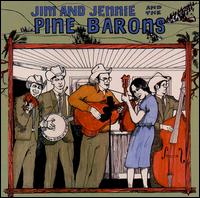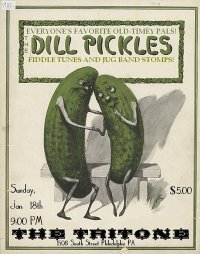[Click image to activate Internets]
 BY BRENDAN SKWIRE How the hell did an old school hardcore punk kid like me get into old timey music? That’s a pretty short story. Even back in the day, I always loved older hardcore better than newer stuff. Youth of Today was fine, but Minor Threat was better (someday i will tell the story of how I made Ian Mackaye lose his temper), and the Sex Pistols was even better than that and so on and so on. The fact is, I’ve always loved old shit, so when I got a little older and my tastes in music began to expand, it was fated that I’d run into bluegrass music, which scratched the itch for a long time (an itch that brought me to Philadelphia with Jim and Jennie and the Pinetops). I thought I’d found my depth. I was SO wrong. A lot of people get bluegrass and old time confused, probably because the instrumentation is so similar, especially the fiddles, guitars, and banjos. But old time is very different from bluegrass, and, as the name indicates, much older.
BY BRENDAN SKWIRE How the hell did an old school hardcore punk kid like me get into old timey music? That’s a pretty short story. Even back in the day, I always loved older hardcore better than newer stuff. Youth of Today was fine, but Minor Threat was better (someday i will tell the story of how I made Ian Mackaye lose his temper), and the Sex Pistols was even better than that and so on and so on. The fact is, I’ve always loved old shit, so when I got a little older and my tastes in music began to expand, it was fated that I’d run into bluegrass music, which scratched the itch for a long time (an itch that brought me to Philadelphia with Jim and Jennie and the Pinetops). I thought I’d found my depth. I was SO wrong. A lot of people get bluegrass and old time confused, probably because the instrumentation is so similar, especially the fiddles, guitars, and banjos. But old time is very different from bluegrass, and, as the name indicates, much older.
Although there are plenty of people happy to debate the topic, it is popularly accepted that bluegrass music was  invented by Bill Monroe in 1940, and that the first recordings with the sound we now know as bluegrass were recorded in 1945. Old time music, on the other hand, largely came over with the settlers and pioneers from England, Ireland, and Scotland. the French brought a lot of music as well.
invented by Bill Monroe in 1940, and that the first recordings with the sound we now know as bluegrass were recorded in 1945. Old time music, on the other hand, largely came over with the settlers and pioneers from England, Ireland, and Scotland. the French brought a lot of music as well.
Bill’s music was new, based on old time fiddling, but also incorporating aspects of blues, popular music, and even a little swing jazz. The beat was different too, closer to yet-to-be-born rock-n-roll than the steadier, more relaxed beat that people could dance to. Also notable in Bill’s music was improvisation: you never really saw any tune performed exactly the same way twice, and every performer gets a chance to take a solo. It’s competitive music. It’s super fun to play. Audiences are generally like jazz audiences, listening respectfully and applauding banjo breaks the same way jazz fans clap after a trumpet solo.
“Old time,” my fiddle-playing friend Nik says, “is like acoustic trance music.” At least the fiddle tunes are. While a bluegrass song is generally about 3 minutes long, old time songs can go on for a lot longer than that. In some sessions, I’ve played “Fiddler’s Dram” for nearly 20 minutes, and could have gone on for a few more bars. Many of these songs are meant to be played at dances or parties, where you could reasonably expect people to be in the middle of a contradance; like today’s trance and electronic musics, most fiddle tunes have few or no lyrics, and a catchy melody that self perpetuates. Some of my favorite old time songs have no resolution whatsoever.
 This brings me to the role of the fiddle in old time music. As I mentioned, in bluegrass, every player takes a solo. In the majority of old time instrumentals, the fiddle player is the only lead player. The banjo is played in the more rhythmic “clawhammer” style, which has a sound not dissimilar from a chicken clucking. The style doesn’t have the same kind of drive as the three finger method used in bluegrass (think of the “Bonnie and Clyde” theme or the intro music to “Car Talk”). There’s no real improvisation in the melody. Old time music may also incorporate instruments that you don’t typically see in a bluegrass band, including washboards, harmonicas, and kazoos. A lot of old time bands don’t have a bass, but some will feature a cello or even a piano.
This brings me to the role of the fiddle in old time music. As I mentioned, in bluegrass, every player takes a solo. In the majority of old time instrumentals, the fiddle player is the only lead player. The banjo is played in the more rhythmic “clawhammer” style, which has a sound not dissimilar from a chicken clucking. The style doesn’t have the same kind of drive as the three finger method used in bluegrass (think of the “Bonnie and Clyde” theme or the intro music to “Car Talk”). There’s no real improvisation in the melody. Old time music may also incorporate instruments that you don’t typically see in a bluegrass band, including washboards, harmonicas, and kazoos. A lot of old time bands don’t have a bass, but some will feature a cello or even a piano.
And then there’s the lyrical weirdness factor. Where bluegrass can be a bit uptight, and has a tendency toward melodramatic lovelorn “gloom despair and agony on me” diatribes (not that there’s anything wrong with that), old time is bawdy, downright offensive, and frequently completely insane. Examples include “Kitty and the Baby”, which is about a drunk cat that scratches a baby, who in turn hits the cat with a hammer; or the aptly named “Prohibition is a Failure”, recorded during those dark days of forced abstinence, and which includes a simple but effective recipe for making beer in the second verse. And don’t get me started on “Black Annie”, which is as bizarre as it is unprintable.
So why am I writing all this stuff about music dating back, in some cases, centuries? Because my band, the Dill Pickles, is playing Saturday. We’re two Narbs and a carpetbagger, playing fiddle tunes and jug band stomps better suited to the Great Depression than our Shiny New World of the Fut…Oh wait? You say it feels like Black Thursday all over again? Well then we’ll fit right in. And so will you: we’ll see you at Fergie’s tonight! We’re gonna party like it’s 1929 (except now the booze is legal).
Brendan Skwire Plays bass in the Dill Pickles and blogs at BRENDAN CALLING.
